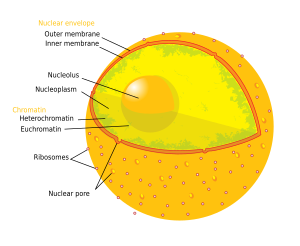Nucleolus
As nucleolus (lat. Nucleolus "Kernchen" dt. Also nucleolus ) or nucleolus is called a tiny bodies, of which one or more in the nucleus of eukaryotic cells are present. It consists mainly of DNA , RNA and protein and is not surrounded by a membrane. Nucleoli contain a special part of the genome , they take part in the production of the 40S and 60S units of the ribosome .
Often the nucleus is centrally located, but sometimes also attached to the nuclear envelope . It is always located in the vicinity of a so-called nucleolus-organizing region (NOR) of a specific chromosome. These are secondary constrictions on acrocentric chromosomes . The genes of the 28S, 18S and 5.8S rRNA , the so-called rDNA , which are components of the ribosomes , are located on the NOR . So nucleoli can be seen as the ribosome factories of the cell.
Location and occurrence
In the human genome, the genes for rRNAs are located on the tips of the acrocentric chromosomes 13, 14, 15, 21 and 22 (four of them are in a homologous position) and each have approx. 50 sequence repetitions, while the highly conservative DNA segment is for a 5S -rRNA lies outside the nucleus organizers.

1. Nucleolus (nuclear body)
2. Cell nucleus (nucleus)
3. Ribosomes
4. Vesicle
5. Rough (granular) ER (ergastoplasm)
6. Golgi apparatus
7. Cytoskeleton
8. Smooth (agranular) ER
9 . mitochondria
10. lysosome
11. cytoplasm (with cytosol and cytoskeleton )
12. peroxisomes
13. centrioles
14 cell membrane
In a diploid human cell there are a total of ten chromosomes with nucleolus organizer regions, so that theoretically up to ten nucleoli should be found per cell nucleus. Normally, however, the cell has only one to three nuclear bodies. This is due to the fact that different NOR chromosomes can “share” a nucleolus.
function
In addition to 28S, 18S and 5.8S rRNA, 5S rRNA and ribosomal proteins are required for the final synthesis of the ribosomal subunits . The ribosomal proteins are transported from the cytosol through the nuclear pores to the nucleolus, where they are used. The small (40S) and large (60S) ribosome subunits are then brought back into the cytosol and there, after they have merged to form the 80S ribosome, on the rough endoplasmic reticulum (ER) or freely in the cytosol, work as a translational unit (see Ribosome ).
structure
In the nucleus itself, pars fibrosa and pars granulosa can be distinguished.
The pars fibrosa can be further subdivided into fibrillar and dense fibrillar components:
- The fibrillar components are seen as several rounded, lightened areas in the nucleolus. Here the transcription of 45S pre-rRNA takes place by means of RNA polymerase I.
- The densely fibrillar components are mostly arranged in the shape of a shell as dark parts around these transcription areas. This is where the 45S rRNA is cut into 28S, 18S and 5.8S rRNA.
The pars granulosa represents the largest part of the nucleolus. Its granular appearance is mainly characterized by the synthesis of pre-ribosomal particles. These consist of the various rRNA forms and associated proteins, with the large ribosomal subunit 49 and the small ribosomal 33 being assigned additional proteins.
Dyeability
During the nucleus doubling of the cell cycle (mitosis), the microscopic stainability of the nucleoli disappears ; they become visible again in the nuclei of the daughter cells .
history
The first interest in the nucleoli aroused John Gurdon and Donald Brown in 1964, who discovered in the clawed frog Xenopus laevis that 25% of its eggs had no nucleolus and none of them were viable. Half of the eggs had only one nucleolus and 25% had two. According to this, the corpuscles had to contain a vital area. 1966 showed Max Birnstiel and Hugh Wallace using hybridization experiments that they ribosomal DNA code.
literature
- Renate Lüllmann-Rauch : Pocket textbook histology , 2nd edition, ISBN 3-13-129242-3
- Campbell: biology
- Bucher and Wartenberg: Cytology, Histology and Microscopic Anatomy of Humans , 12th completely revised edition, ISBN 3-456-82785-7
- Németh A, Conesa A, Santoyo-Lopez J, et al. : Initial genomics of the human nucleolus . In: PLoS Genet . . 6, No. 3, 2010, p. E1000889. doi : 10.1371 / journal.pgen.1000889 . PMID 20361057 . PMC 2845662 (free full text).
Individual evidence
Web links
- Alexander Schlaak: Organizational principle of the human genome identified. University of Regensburg, press release from April 13, 2010 at the Informationsdienst Wissenschaft (idw-online.de), accessed on September 15, 2015.
